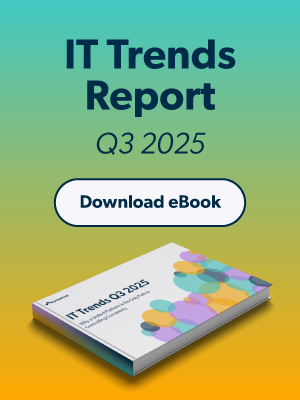Updated on February 14, 2025
Efficient identity and access management (IAM) is critical in today’s complex IT environments. Yet, one common challenge organizations face is managing user permissions effectively without overcomplicating structure or compromising security. Role mining emerges as a powerful solution to optimize role-based access control (RBAC), reduce unnecessary permissions, and enhance overall security and compliance.
This article dives into the concept of role mining, its techniques, benefits, and challenges, along with steps to implement role mining.
What is Role Mining?
Role mining refers to the process of analyzing existing access data, patterns, and permissions to identify roles that best align with organizational needs. By uncovering hidden roles or permissions across users, role mining enables a systematic approach to defining or refining RBAC policies.
It’s essential to distinguish role mining from role engineering. While role engineering involves designing roles from scratch based on theoretical needs, role mining takes a more data-driven approach, analyzing actual permissions and user behaviors to derive roles.
Why is Role Mining Important?
Role mining is a critical process for organizations striving to enhance their access control frameworks.
By leveraging data-driven insights, it enables the identification of redundant or excessive permissions, helping IT teams to:
- Enhance Security: By identifying over-permissioned users and cleaning up access privileges, role mining minimizes potential attack vectors.
- Save Time: Automating role identification reduces the manual effort required to manage permissions.
- Ensure Compliance: Aligning roles with access standards supports adherence to regulatory and audit requirements.
- Streamline Workflows: Simplified role structures make it easier to manage users and their access to resources.
Key Role Mining Techniques
Role mining can be executed using multiple methodologies. Here are the three most common approaches and their unique advantages:
1. Top-Down Approach
This method starts with predefined roles based on organizational needs and then refines them using data analysis.
- Advantages: Aligns closely with business processes and compliance requirements.
- Challenges: Time-consuming and may overlook specific user behaviors.
Example Use Case: An enterprise might define initial roles (e.g., “HR Manager” or “Finance Associate”) based on policy and then validate these roles against existing access logs for refinement.
2. Bottom-Up Approach
This method derives roles directly from analyzing user permissions and access patterns.
- Advantages: Fully data-driven and adaptable to dynamic environments.
- Challenges: Can create overly granular roles that require further consolidation.
Example Use Case: A multinational corporation could analyze access logs to define roles for employees in similar positions across different regions.
3. Hybrid Approach
The hybrid approach combines both top-down and bottom-up methods for balanced and comprehensive role creation.
- Advantages: Offers both organizational alignment and adaptability to real-world data.
- Challenges: Requires more resources and effort to execute.
Example Use Case: A healthcare organization could use predefined roles for regulatory compliance while also analyzing access patterns to address specific operational needs.
Examples of Data Sources
Successful role mining requires gathering and analyzing data from key sources such as system logs, user activity records, access control systems, and IAM (Identity and Access Management) databases.
These sources provide critical insights into how users interact with systems, which permissions are regularly used, and any patterns or anomalies in access behavior. By consolidating this information, organizations can identify redundant roles, improve access management policies, and enhance overall security.
Challenges and Limitations of Role Mining
Implementing role mining can be challenging for a number of reasons, including:
Data Complexity
Large datasets containing thousands of users and roles can quickly overwhelm even the most robust tools, making the initial setup a complex and time-consuming process.
This challenge is often compounded by the need to ensure accuracy, manage permissions effectively, and avoid any potential security risks during configuration.
Risk of Misinterpretation
Without thorough analysis, organizations risk creating roles that fail to align with the actual needs and responsibilities of users. This can lead to inefficiencies, miscommunication, and a lack of clarity in how tasks are handled, ultimately hindering the organization’s ability to meet its goals effectively.
Change Resistance
Introducing new roles often meets resistance from users and administrators who are accustomed to the existing access structure and workflows.
This resistance can stem from a reluctance to adapt to change, concerns about increased complexity, or uncertainty about how the new roles will impact their daily responsibilities. Addressing these concerns through clear communication and training is crucial for a smooth transition.
Privacy Concerns
Handling sensitive user data during permission analysis raises significant privacy and compliance concerns, as it involves managing personal information that must be protected against unauthorized access.
Ensuring compliance with data protection regulations, such as GDPR or CCPA, is critical, along with implementing robust security measures to safeguard user trust and prevent potential legal or reputational risks.
How to Implement Role Mining
A structured approach ensures successful role mining with minimal challenges.
Step 1. Collect and Clean Data
Gather access data from IAM systems, logs, and control systems, ensuring it is accurate, comprehensive, and up-to-date. This includes tracking user permissions, authentication records, and access control changes to provide a clear and detailed picture of system activity and security compliance.
Step 2. Choose the Right Tools
Select automated role mining tools that align with your organization’s scope, complexity, and specific needs. Consider tools that can handle large data sets, integrate seamlessly with your existing systems, and provide actionable insights to streamline role management.
Step 3. Analyze Access Patterns
Use your chosen method—whether it’s top-down, bottom-up, or a hybrid approach—to thoroughly analyze user permissions. Evaluate the specific access each user has and identify patterns or overlaps. Then, organize these permissions into well-defined roles that align with your organization’s structure and needs.
This process ensures a streamlined, efficient system for managing access and maintaining security.
Step 4. Validate and Test Roles
To ensure a smooth transition, engage stakeholders early in the process to gather input and create alignment.
Test the roles in a controlled environment, such as a pilot program or smaller team setting, to observe how they function in practice. Collect detailed feedback from participants and stakeholders, analyze the results, and make necessary adjustments to refine the roles.
This iterative process helps address potential challenges before rolling out the changes across the entire organization.
Step 5. Monitor and Optimize
Continuously monitor role efficacy, review permissions regularly, and update roles to adapt to changing business needs.
Real-World Applications of Role Mining
Role mining adds value across different industries, and for different reasons. Here are a few real-world examples:
Financial Sector for Compliance
A multinational bank successfully utilizes role mining to meet stringent regulatory requirements and improve internal security.
By analyzing employee access patterns and responsibilities, the bank is able to create precise roles with clearly defined permissions, ensuring that employees only have access to the resources they truly needed for their jobs. This approach not only enhances compliance with regulations but also minimizes the risk of unauthorized access or potential security breaches.
Healthcare Organizations
A hospital implements a hybrid approach to effectively manage dynamic permissions for doctors, nurses, and administrative staff, ensuring that each role has the appropriate level of access to sensitive patient information.
This system not only streamlines workflows but also maintains strict compliance with HIPAA regulations, safeguarding patient privacy while allowing staff to perform their duties efficiently.
Cloud-Based Environments
A tech firm utilizes advanced role mining techniques to analyze and streamline cross-platform permissions, ensuring users have the right level of access across multiple SaaS applications.
By identifying patterns in user roles and permissions, they optimize access controls, reduce redundancies, and enhance overall security while improving operational efficiency.
Role mining should not be considered optional for IT managers and security experts aiming for optimized IAM. The world of IT is becoming increasingly complex, with overlapping systems and a growing need for compliance and security.
By harnessing role mining, your organization will gain streamlined IAM processes, enhanced protection against threats, and smoother compliance audits, reducing regulatory risks.
Frequently Asked Questions
What is role mining, and why is it important?
Role mining is the process of analyzing and organizing user permissions within an organization to identify roles based on access patterns. It helps improve security, streamline access management, and ensure compliance.
What are the key techniques used in role mining?
Key techniques include data analysis, clustering, and pattern recognition to group users with similar permissions and define roles accordingly.
What challenges can organizations face during role mining?
Organizations may struggle with inaccurate or outdated data, complex access structures, and resistance to change when implementing new roles.
How does role mining improve security and compliance?
Role mining reduces risks by eliminating excessive or unnecessary access, ensuring users only have permissions relevant to their roles, meeting regulatory requirements.
What kind of tools are commonly used for role mining?
Common tools include identity governance platforms, access management software, and data analytics tools designed for role discovery and optimization.
Glossary of Terms
Identity and Access Management (IAM): A framework of policies and technologies ensuring the right individuals access the right resources at the right time.
Role Mining: The process of analyzing user access patterns to identify common roles and improve access management.
Role-Based Access Controls (RBAC): A security approach that assigns permissions to users based on their roles within an organization.
Role Engineering: The practice of designing and defining roles to align with organizational needs and security requirements.





